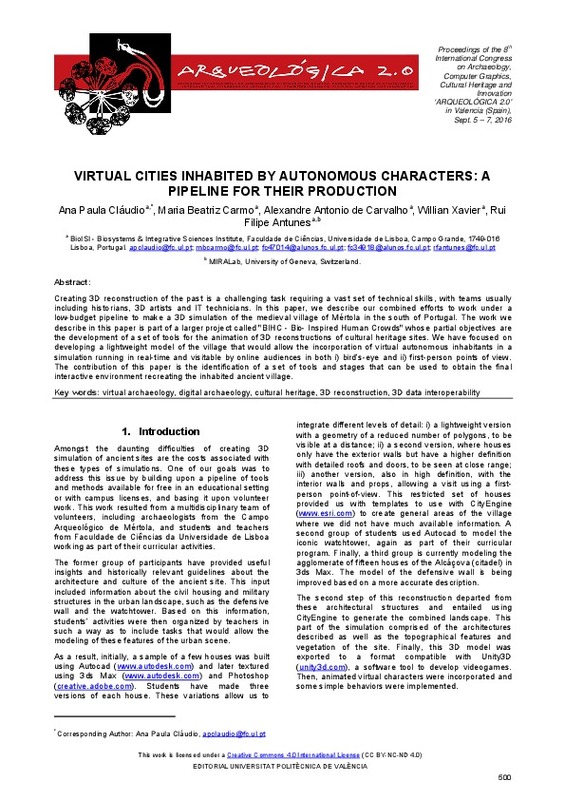JavaScript is disabled for your browser. Some features of this site may not work without it.
Buscar en RiuNet
Listar
Mi cuenta
Estadísticas
Ayuda RiuNet
Admin. UPV
VIRTUAL CITIES INHABITED BY AUTONOMOUS CHARACTERS: A PIPELINE FOR THEIR PRODUCTION
Mostrar el registro sencillo del ítem
Ficheros en el ítem
| dc.contributor.author | Cláudio, Ana Paula
|
es_ES |
| dc.contributor.author | Carmo, Maria Beatriz
|
es_ES |
| dc.contributor.author | Carvalho, Alexandre Antonio
|
es_ES |
| dc.contributor.author | Xavier, Willian
|
es_ES |
| dc.contributor.author | Antunes, Rui
|
es_ES |
| dc.date.accessioned | 2017-07-31T09:19:49Z | |
| dc.date.available | 2017-07-31T09:19:49Z | |
| dc.date.issued | 2016-10-27 | |
| dc.identifier.isbn | 9788490484555 | |
| dc.identifier.uri | http://hdl.handle.net/10251/85990 | |
| dc.description.abstract | [EN] Creating 3D reconstruction of the past is a challenging task requiring a vast set of technical skills, with teams usually including historians, 3D artists and IT technicians. In this paper, we describe our combined efforts to work under a low-budget pipeline to make a 3D simulation of the medieval village of Mértola in the south of Portugal. The work we describe in this paper is part of a larger project called "BIHC - Bio- Inspired Human Crowds" whose partial objectives are the development of a set of tools for the animation of 3D reconstructions of cultural heritage sites. We have focused on developing a lightweight model of the village that would allow the incorporation of virtual autonomous inhabitants in a simulation running in real-time and visitable by online audiences in both i) bird’s-eye and ii) first-person points of view. The contribution of this paper is the identification of a set of tools and stages that can be used to obtain the final interactive environment recreating the inhabited ancient village | es_ES |
| dc.format.extent | 4 | es_ES |
| dc.language | Inglés | es_ES |
| dc.publisher | Editorial Universitat Politècnica de València | es_ES |
| dc.relation.ispartof | 8th International congress on archaeology, computer graphics, cultural heritage and innovation | es_ES |
| dc.rights | Reconocimiento - No comercial - Sin obra derivada (by-nc-nd) | es_ES |
| dc.subject | Data acquisition | es_ES |
| dc.subject | Photogrammetry | es_ES |
| dc.subject | Remote sensing | es_ES |
| dc.subject | Documentation | es_ES |
| dc.subject | Cultural heritage | es_ES |
| dc.subject | Digitisation | es_ES |
| dc.subject | 3D modelling | es_ES |
| dc.subject | Virtual archaeology | es_ES |
| dc.subject | Virtual museums | es_ES |
| dc.subject | Virtual exhibitions | es_ES |
| dc.subject | Gaming | es_ES |
| dc.subject | Collaborative environments | es_ES |
| dc.subject | Internet technology | es_ES |
| dc.subject | Social media | es_ES |
| dc.subject | Architecture | es_ES |
| dc.title | VIRTUAL CITIES INHABITED BY AUTONOMOUS CHARACTERS: A PIPELINE FOR THEIR PRODUCTION | es_ES |
| dc.type | Capítulo de libro | es_ES |
| dc.type | Comunicación en congreso | es_ES |
| dc.identifier.doi | 10.4995/arqueologica8.2015.4185 | |
| dc.rights.accessRights | Abierto | es_ES |
| dc.description.bibliographicCitation | Cláudio, AP.; Carmo, MB.; Carvalho, AA.; Xavier, W.; Antunes, R. (2016). VIRTUAL CITIES INHABITED BY AUTONOMOUS CHARACTERS: A PIPELINE FOR THEIR PRODUCTION. En 8th International congress on archaeology, computer graphics, cultural heritage and innovation. Editorial Universitat Politècnica de València. 500-503. https://doi.org/10.4995/arqueologica8.2015.4185 | es_ES |
| dc.description.accrualMethod | OCS | es_ES |
| dc.relation.conferencename | ARQUEOLÓGICA 2.0 - 8th International Congress on Archaeology, Computer Graphics, Cultural Heritage and Innovation | es_ES |
| dc.relation.conferencedate | September 05-07,2016 | es_ES |
| dc.relation.conferenceplace | Valencia, Spain | es_ES |
| dc.relation.publisherversion | http://ocs.editorial.upv.es/index.php/arqueologica20/arqueologica8/paper/view/4185 | es_ES |
| dc.description.upvformatpinicio | 500 | es_ES |
| dc.description.upvformatpfin | 503 | es_ES |
| dc.type.version | info:eu-repo/semantics/publishedVersion | es_ES |
| dc.relation.pasarela | OCS\4185 | es_ES |








